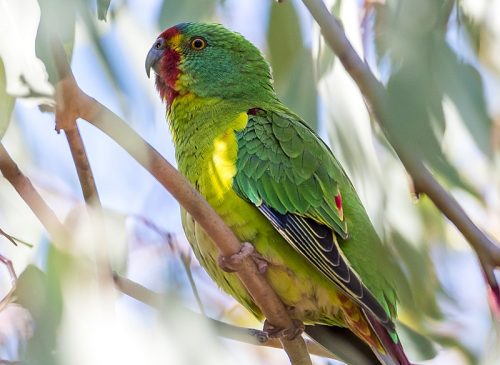
CANBERRA’S inviting woodlands are becoming an important flight diversion for a species of parrot under threat, suffering one of Australia’s worse predation rates.
More than 50 swift parrots have been sighted around the Territory over the past week, as the critically-endangered bird migrates from Tasmania to mainland Australia looking for food ahead of settling anywhere from south-east Queensland to that state’s far north.
Researchers from ANU have found that there are fewer than 300 swift parrots left in the wild after previous estimates had the population count closer to an optimistic 2000 birds.
Demographic information suggest the species could be extinct by 2031 based on the results of genetic evidence of earlier studies.
“The harvesting of timber within a swift parrot habitat on the NSW south coast – and in Tasmania – is significantly impacting the long-term viability of the species,” Dr Debbie Saunders, from ANU, said.
“Swift parrots prefer foraging in big, older trees with natural hollows, so the logging of a mature habitat reduces both the availability and quality of food resources.”
The nomadic migrant is under threat from sugar gliders after the possum species hunts its prey where logging is most severe among Tasmania’s heavy operations of forestation.
Canberra is also considered a preferred option for the swift parrot while a winter habitat of the NSW south coast is being logged.
ACT Minister for the Environment Rebecca Vassarotti said authorities are very aware of the national environmental devastation that needs to be reversed urgently to save the parrot.
“The ACT has already taken proactive steps to conserve habitat for these parrots and other woodland-dependent species,” Ms Vassarotti said.
“We are managing and conserving the most intact woodland in Australia, including critically endangered Yellow Box – Blakely’s Red Gum Woodland.
“Logging represents the single biggest threat to the survival of the swift parrot in the wild.”
Ms Vassarotti has called on the Commonwealth to urgently improve Australia’s Environment Protection and Biodiversity Conservation Act.
Logging is largely exempt from the EPBC Act under a series of regional forestry agreements between federal government and the states.
Ms Vassarotti wants the Commonwealth to strengthen protections for native forests and remove the logging industry’s special exemption from national environmental law.
Former lawyer Graeme Samuel led a once-a-decade review of national environment laws, concluding that the EPBC Act is “failing to stem an extinction crisis”.
“If there’s no change, the species is on a 10-year track to extinction,” Ms Vassarotti said.
“We need to see leadership from the federal government, including a plan to improve environmental standards rather than accept ongoing environmental decline.”
“Scientists and conservation groups have said the forestry exemption is one of a series of failures in the design and implementation of the legislation that favours industry over environment.”
Who can be trusted?
In a world of spin and confusion, there’s never been a more important time to support independent journalism in Canberra.
If you trust our work online and want to enforce the power of independent voices, I invite you to make a small contribution.
Every dollar of support is invested back into our journalism to help keep citynews.com.au strong and free.
Thank you,
Ian Meikle, editor








Leave a Reply